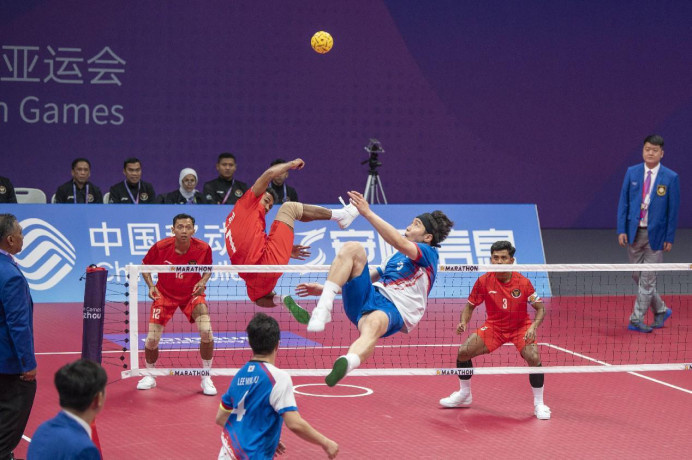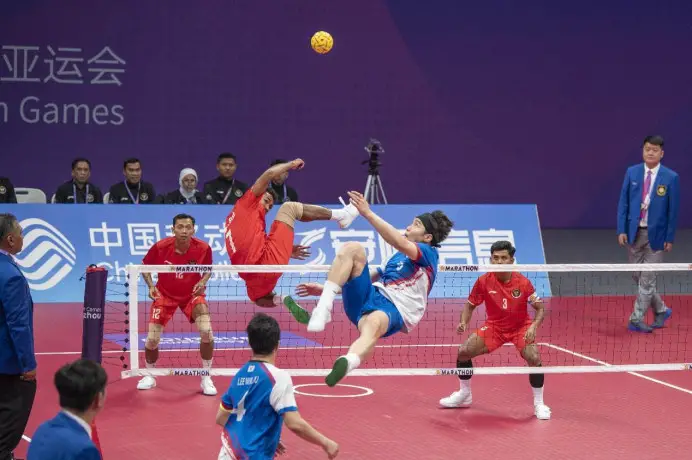By Li Yang, Zheng Yi, People's Daily

Photo shows a men's sepak takraw game between Indonesia and South Korea at the 19th Asian Games in Hangzhou, east China's Zhejiang province, Sept. 24, 2023. (Photo by Hu Xiaofei/People's Daily Online)
Among the 40 sports at the Hangzhou Asian Games, nine are non-Olympic, including mind sports go, chess, bridge, and e-sports, martial arts jujitsu, Kurash, and karate, as well as squash, cricket, sepak takraw, kabaddi, Wushu, dragon boat, and softball.
Many of these events carry distinct Asian characteristics and thus build a stage to showcase the blending of sports and cultures.
At the cricket venue of the Hangzhou Asian Games, cheers frequently arose from the stands.
"We bought tickets to several cricket matches. Cricket is hugely popular in India, just like table tennis in China. We've been watching cricket games and playing cricket since we were young," said Batra, an Indian spectator who came to Hangzhou for the Asian Games.
Asia is vast in territory with a large population, diverse cultures and a long history.
"The selection of non-Olympic sports at the Asian Games fully considered the popularity of different sports across Asia," said Zhu Qinan, director of the competition department of the Hangzhou Asian Games Organizing Committee.
For instance, Wushu, sepak takraw, cricket, jujitsu and Kurash carry regional characteristics of East Asia, Southeast Asia, South Asia, Central Asia and West Asia respectively, he explained.
These non-Olympic sports have enriched the competitions at the Asian Games and interpret the beauty of diversity of Asian sports, Zhu remarked.
The Asian Games is like a window, which not only brings regionally popular sports into public view, but also facilitates cultural exchanges and mutual learning between different cultures.
At the sepak takraw games of the Hangzhou Asian Games, whether scoring or making a turnover, players from both teams would gather in a circle on either side of the court, join hands with their teammates, and shout out loud together.
"This was my first time watching a sepak takraw match. I felt the teamwork essence of this sport," a spectator from Jinhua, Zhejiang province said.
The roster of non-Olympic sports at each Asian Games has been quite dynamic, with certain sports "rotating in and out" over the years and new ones frequently making debut appearances.
"The Asian Games has always maintained an open and inclusive attitude, continuously embracing emerging sports that are popular and carry the features of the times," said Liu Mingyi, a professor with Wuhan Sports University.
In his opinion, this kind of flexible arrangement helps the Asian Games maintain appeal and get closer to the general public.
Many of these events carry distinct Asian characteristics and thus build a stage to showcase the blending of sports and cultures.
At the cricket venue of the Hangzhou Asian Games, cheers frequently arose from the stands.
"We bought tickets to several cricket matches. Cricket is hugely popular in India, just like table tennis in China. We've been watching cricket games and playing cricket since we were young," said Batra, an Indian spectator who came to Hangzhou for the Asian Games.
Asia is vast in territory with a large population, diverse cultures and a long history.
"The selection of non-Olympic sports at the Asian Games fully considered the popularity of different sports across Asia," said Zhu Qinan, director of the competition department of the Hangzhou Asian Games Organizing Committee.
For instance, Wushu, sepak takraw, cricket, jujitsu and Kurash carry regional characteristics of East Asia, Southeast Asia, South Asia, Central Asia and West Asia respectively, he explained.
These non-Olympic sports have enriched the competitions at the Asian Games and interpret the beauty of diversity of Asian sports, Zhu remarked.
The Asian Games is like a window, which not only brings regionally popular sports into public view, but also facilitates cultural exchanges and mutual learning between different cultures.
At the sepak takraw games of the Hangzhou Asian Games, whether scoring or making a turnover, players from both teams would gather in a circle on either side of the court, join hands with their teammates, and shout out loud together.
"This was my first time watching a sepak takraw match. I felt the teamwork essence of this sport," a spectator from Jinhua, Zhejiang province said.
The roster of non-Olympic sports at each Asian Games has been quite dynamic, with certain sports "rotating in and out" over the years and new ones frequently making debut appearances.
"The Asian Games has always maintained an open and inclusive attitude, continuously embracing emerging sports that are popular and carry the features of the times," said Liu Mingyi, a professor with Wuhan Sports University.
In his opinion, this kind of flexible arrangement helps the Asian Games maintain appeal and get closer to the general public.
 Menu
Menu
 Hangzhou Asian Games highlights diverse Asian sports culture via non-Olympic sports
Hangzhou Asian Games highlights diverse Asian sports culture via non-Olympic sports
















